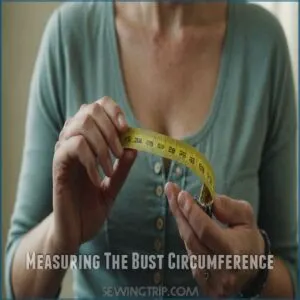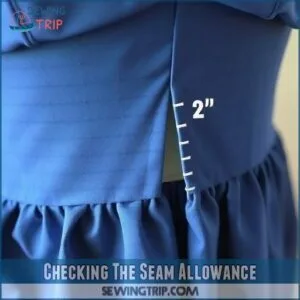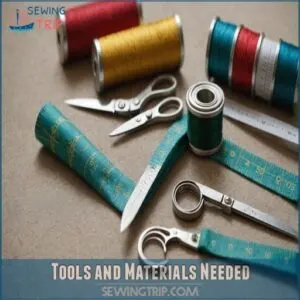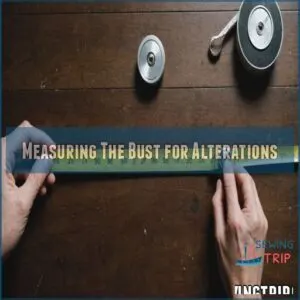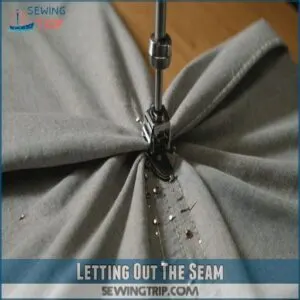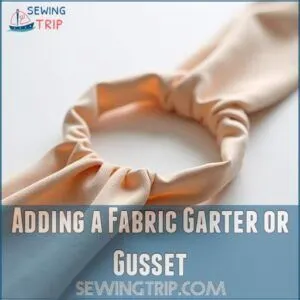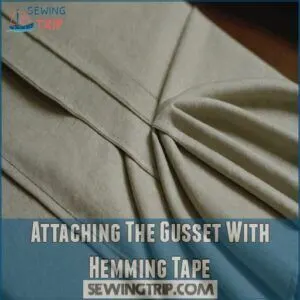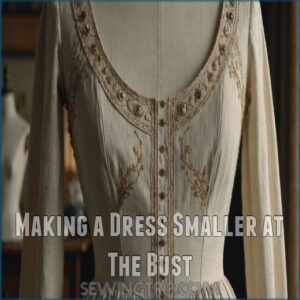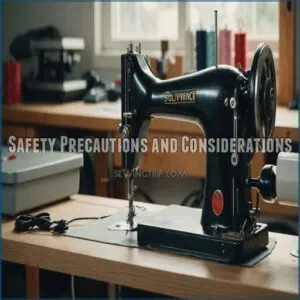This site is supported by our readers. We may earn a commission, at no cost to you, if you purchase through links.
 If you’re wondering how to make a dress bigger in the bust, start by checking the seam allowance inside your dress.
If you’re wondering how to make a dress bigger in the bust, start by checking the seam allowance inside your dress.
Letting out the seams is often the simplest solution.
You could also add a diamond-shaped gusset on the sides for a bit of extra room.
If you’re feeling adventurous, consider inserting a side panel, though it might involve adjusting more than just the bust.
Who knew something as simple as a fabric gusset could turn you into a DIY wizard?
Stick around to uncover more easy methods that’ll help you master the art of making dresses fit like a glove.
Table Of Contents
- Key Takeaways
- Why Dresses Often Fit Poorly
- Assessing The Dress and Fabric
- Tools and Materials Needed
- Measuring The Bust for Alterations
- Expanding The Bust of a Dress
- Altering The Bust on a Wedding Dress
- Temporary Solutions for a Tight Bust
- Making a Dress Smaller at The Bust
- Safety Precautions and Considerations
- Frequently Asked Questions (FAQs)
- Conclusion
Key Takeaways
- Check the seam allowance; if there’s extra fabric, let out the seams for a simple way to give your dress more room in the bust.
- Add a diamond-shaped gusset to the sides or insert a side panel to creatively increase the bust size without altering other parts of the dress.
- Measure the fullest part of your bust accurately, ensuring the dress alterations give a comfortable fit without unnecessary adjustments.
- Consider temporary solutions like fabric garters or temporary darts if you’re short on time or prefer not to sew.
Why Dresses Often Fit Poorly
You’ll often find that dresses don’t fit perfectly in the bust because most are made with limited seam allowance and standard measurements that don’t match your unique shape.
When you’re shopping off the rack, you’re trying to fit your three-dimensional curves into a dress that’s been designed with just one size in mind, which explains why you might feel squeezed in all the wrong places.
Seam Allowance Limitations
Frustration lurks in every seam of a too-tight dress, especially when you discover limited seam allowance.
When examining seam allowances, it’s important to factor in the fabric type, its tendency to fray, and the original dress construction methods, including seam types and bodice lining, as discussed in the art of Letting out seams for comfort.
You’ll typically find ¼ to 1 inch of extra fabric tucked into each seam, but some dresses, particularly ready-to-wear or vintage, skimp on this important detail.
Without adequate seam allowance, your alteration options become severely limited, forcing you to explore creative solutions or consider professional help.
Lack of Bust Accommodation
Dress manufacturers often follow standard sizing charts that don’t account for your unique bust shape and size.
Considering this, you can try using a bust size extender to find a better fit.
You’ll notice this especially in fitted styles, where the fabric might pull across your chest or create unflattering gaps.
Ready-to-wear dresses typically favor a B-cup size, leaving you with limited options if you’re smaller or larger.
This one-size-fits-all approach can make finding the perfect fit challenging.
Assessing The Dress and Fabric
Before you start cutting or ripping seams, you’ll need to check your dress’s structure and fabric type to choose the right alteration method.
You’ll want to measure the bust circumference and seam allowance carefully, as these measurements will determine whether you can let out the seams or need to try a different approach like adding extra fabric panels.
Does The Dress Have Sleeves?
Sleeves can make or break your alteration plans.
Different sleeve styles – from cap to full-length – impact how much you can adjust the bust.
Sleeveless dresses offer more flexibility since you won’t need to match fabric or worry about arm mobility.
But if your dress has sleeves, don’t worry!
You’ve got options like letting out the side seams or adding fabric panels under the arms.
Measuring The Bust Circumference
Getting the right measurements is like having a roadmap to success.
Before you start any alterations, grab your measuring tape and follow these steps:
- Measure around the fullest part of your bust while wearing the bra you’ll use with the dress.
- Take three measurements to confirm accuracy – bodies shift naturally.
- Record your numbers carefully – they’re your secret weapon for perfect alterations.
Remember, measuring twice now saves headaches later!
Checking The Seam Allowance
Now that you’ve got your measurements, let’s check what you have to work with.
Open the side seams carefully with a seam ripper and measure from the stitching line to the fabric edge.
You’ll need at least ¼ inch of seam allowance to let out the dress.
Remember, some dresses hide extra fabric in their seams – it’s like finding hidden treasure!
Tools and Materials Needed
You’ll need a few basic tools to make your dress fit perfectly in the bust, and you probably already have most of them in your sewing kit.
Before you begin your alterations, gather a measuring tape, seam ripper, and some fabric garters or gussets to make sure you’re ready to tackle this project with confidence.
Measuring Tapes
Choosing the right measuring tape makes all the difference in your dress alterations, especially when considering the importance of accurate body measurements, such as measuring around the fullest part of the bust, as explained in how to take measurements for sewing.
You’ll need both a flexible fabric tape measure and a metal retractable one.
Keep your fabric tape flat and taut when measuring curves – any slack will throw off your measurements.
Store tapes flat to prevent stretching, and always double-check your numbers.
Pro tip: mark key measurements with chalk for easy reference.
Seam Rippers
You’ll need to learn how to undo sewing using a seam ripper to remove stitches without damaging the fabric, which involves techniques like carefully removing overlock stitches. You’ll need a trusty seam ripper to carefully undo stitches without damaging the fabric.
Look for one with a sharp point and comfortable grip – a quality ripper makes all the difference between smooth sailing and frustration.
Keep safety in mind by always working with good lighting and cutting away from yourself.
Store the seam ripper with its protective cap when not in use.
Fabric Garters or Gussets
Fabric garters and gussets are your secret weapons when a dress needs extra room.
After putting down your seam ripper, grab these lifesavers – they’ll give you breathing space without major alterations.
Keep elastic fabric garters handy for quick fixes, and stock up on gusset materials that match your dress fabric.
Both options let you add width exactly where you need it most.
Measuring The Bust for Alterations
You’ll need precise measurements of both your bust and the dress to make sure your alterations fit perfectly.
Before you start snipping and sewing, understanding the concept of ease in sewing and its impact on garment fit is crucial for making adjustments that both flatter and comfort the body. Taking accurate measurements will help you determine exactly how much fabric you’ll need to let out to achieve that perfect fit.
Measuring The Person’s Bust
Now that you’ve got your tools ready, let’s get those perfect measurements.
For accurate bust measurements, grab a friend – they’re your secret weapon for precision.
Here’s exactly where to measure:
- Right across the fullest part of your bust
- Keep the measuring tape parallel to the ground
- Make sure it’s snug but not tight
- Take a deep breath while measuring
Your friend can help make sure the tape stays level around your back, giving you the most accurate measurement possible.
Measuring The Dress’s Bust
After getting your measurements right, turn your attention to the dress itself.
Lay it flat on a clean surface and measure the bust line from seam to seam.
Double this number to get the full circumference.
Remember to measure both the front and back pieces separately – sometimes they can differ slightly.
Keep the measuring tape parallel to the floor for the most accurate reading.
Calculating The Amount to Let Out
Simple math makes altering your dress a breeze.
Subtract the dress’s bust measurement from your bust measurement to find how much fabric you need.
For example, if your bust is 38 inches and the dress measures 36 inches, you’ll need 2 inches total.
Divide this number by 4 since you’re working with two seams on both sides.
That’s ½ inch per seam.
Expanding The Bust of a Dress
You’ll need about 30 minutes and basic sewing skills to expand your dress’s bust using either the seam allowance method or by adding a fabric gusset.
If you’ve measured carefully and found that your dress is too tight in the chest, you can make it bigger by following these straightforward alterations that work on most dress styles.
Letting Out The Seam
Letting out dress seams requires precision and patience, but you’ve got this.
To confirm you’re making the right adjustments, compare your high bust and full bust measurements to the pattern’s sizing guide, adjusting if there’s more than a 2-inch difference, as outlined in techniques for adjusting dress bust darts.
Once you’ve confirmed your measurements, here’s your game plan:
- Create a clear workspace and turn the dress inside out
- Carefully remove the original seam stitching
- Press the seam allowance flat with an iron, then restitch along your new seam line
Remember to work slowly – you can always take more fabric out, but you can’t put it back!
Adding a Fabric Garter or Gusset
Adding a fabric garter or gusset can transform a too-tight dress into your perfect fit.
To find the right fabric for your garter, you can search for dress garter fabric options that match your needs.
For garters, measure the area where you need extra room and cut a strip of elastic-backed fabric to match.
With gussets, you’ll want triangular pieces that taper at both ends.
Choose fabrics that match your dress’s weight and stretch – lightweight chiffon won’t work with heavy satin.
Attaching The Gusset With Hemming Tape
Once you’ve cut your gusset fabric to size, secure it precisely with hemming tape along the edges.
Place double-sided tape on both the gusset and dress edges, then press firmly for 30 seconds.
For extra security, use hook-and-loop strips at stress points.
Test the bond by gently tugging – if it holds, you’re good to go.
Don’t skip the pressing step!
Altering The Bust on a Wedding Dress
You’ll find two main ways to make your wedding dress larger in the bust: using the built-in seam allowance or adding a fabric gusset.
If your dress doesn’t have enough seam allowance to let out, you can create extra room by carefully inserting a matching fabric panel that blends seamlessly with your gown.
Using The Seam Allowance
First, check your wedding dress’s seam allowance.
Grab your measuring tape; you’ll need it!
A generous seam allowance—more than ¼ inch—means you can let out the seams to enlarge the bust.
Carefully measure the existing seam allowance.
This is important for determining how much you can safely adjust.
Remember, gentle adjustments are key to avoid ruining your dress.
Small changes make a big difference!
Adding a Fabric Gusset
If the seam allowance isn’t enough, a fabric gusset adds room and style.
Gusset placement is key—aim for a natural look.
When choosing your gusset fabric, you can find a wide selection of specialty fabrics online at gusset fabric stores.
For sewing, try these techniques:
- Use hemming tape for stability.
- Secure with hook-and-loop adhesive strips.
- Experiment with gusset for different styles for creativity.
Cutting The Gusset Fabric
Gusset fabric size and type matter when crafting your perfect fit. Start by measuring carefully, then cut using sharp tools for precision. Lay out your gusset, making sure it’s wide enough to cover, and add an extra couple of inches for seam allowance. This neat trick will give you room to breathe—and maybe even sneak in dessert.
| Task | Details | Notes |
|---|---|---|
| Measure Gusset | Add extra 2 inches | For flexibility |
| Choose Fabric Type | Match with dress | Avoid contrast |
| Use Cutting Tools | Scissors/sewing shears | Make sure they’re sharp |
| Plan Placement | Align with seams | Check fit visually |
Temporary Solutions for a Tight Bust
When your dress feels snug in the bust, you can quickly try a few tricks to get a better fit without making permanent changes.
Fabric garters, adding a temporary dart, or letting out the seam can help you breathe easier and enjoy the day without wardrobe worries.
Using Fabric Garters
Thinking of ways to expand your dress’s bust without major alterations? Consider fabric garters. These little wonders can provide extra room.
Garter types vary, but the key is choosing the right material for a smooth finish.
Garter placement is essential, so aim for hidden areas.
They’re easy to attach and remove, and garter costs won’t break the bank.
Adding a Temporary Dart
Feeling tight in your dress? Adding a temporary dart might just save the day. Here’s how to do it:
- Temporary Dart Placement: Pin the fabric where you need more room.
- Dart Size Considerations: Make sure it’s not too small or too large.
- Dart Fabric Matching: Make sure the dart blends seamlessly.
- Dart Removal: Easily undo it later.
Letting Out The Seam Temporarily
After your temporary dart adventure, let’s loosen the seams without getting too committed.
When seam allowance limits are pressing, temporary seam letting is your friend, but first, make sure your seams are in good condition to avoid any further damage by learning how to fix unraveling seam.
Pros? Quick, no fuss. Cons? Limited extra room.
If your dress fit challenges persist, consider fabric garter benefits for a hands-free fix. Remember, bust alteration options grant freedom, not stress.
| Challenge | Solution | Emotion |
|---|---|---|
| Tight Bust | Temporary Seam Letting | Relief |
| Still Tight | Fabric Garter Benefits | Empowerment |
| Seam Struggles | Seam Allowance Limits | Frustration |
| Need Options | Bust Alteration Options | Flexibility |
| Stress Factor | Dress Fit Challenges | Determination |
Making a Dress Smaller at The Bust
So, your dress is a little too roomy in the bust?
To achieve a perfect fit, it’s essential to compare your body measurements to the pattern size chart and consider factors like body shape changes and sizing guides for choosing the right pattern size, as explained in the guide on how to adjust a sewing pattern. Let’s learn how to easily take it in using simple techniques like seam adjustments or adding darts for a perfect fit.
Taking in The Seam
When taking in a seam to make a dress smaller at the bust, your trusty seam ripper becomes your best friend.
Gently unpick the stitches and use a measuring tape for precision.
Adjust the seam line with small, even stitches to maintain its structure.
Opt for sturdy fabrics to prevent ripping, ensuring a sleek fit without compromising the dress’s integrity.
Darting The Bust
Got a dress that’s baggy in the bust? Try darting it for a snug fit.
Darts are essential shaping elements that involve precise techniques like using tailor’s chalk or tracing wheel to create dimension and contour, shape fabric without drastic changes.
Start with these steps:
- Dart placement: Pin at the fullest bust point.
- Dart size: Adjust based on excess fabric.
- Dart direction: Aim in the direction of the bust apex.
Now, your dress flaunts your figure, not flaunts it!
Removing Excess Fabric
Feeling hemmed in by extra fabric at the bust? It’s time to trim things down smartly.
Using hand-stitching allows precision over machine methods, especially with varying dress fabric types.
Trim excess with care, respecting seam allowance limits to avoid fabric waste.
Think of it as sculpting—slow, methodical, yet rewarding.
Embrace the art, and let your dress fit flawlessly!
Safety Precautions and Considerations
When altering a dress to make it bigger in the bust, it’s essential to avoid over-altering and ruining its original structure.
Professional Tailor
If you’re unsure about making the changes yourself, don’t hesitate to consult a professional tailor to preserve your dress’s beauty.
Avoiding Over-Alteration
You might’ve mastered shrinking the bust, but making it bigger? That’s a different ballgame!
Avoid over-altering by checking the fabric type—some can’t handle too much stretching.
Alteration risks loom large if you’re too ambitious.
If things are getting dicey, professional help is your trusty parachute.
Remember, not all dresses are created equal; some have dress limitations you’d better respect!
Preserving The Dress’s Structure
Think about preservation like handling a fragile masterpiece.
When altering the bust, you’re not just playing with fabric; you’re sculpting its structure.
Keep seams aligned, so the dress doesn’t lose its character.
Alter gradually—overdoing it can warp the design.
Balance is your best friend here.
It’s all about working with what the dress originally intended.
Considering Professional Alterations
Facing a tricky alteration? Before diving in, consider a professional. Their expertise saves you time and risk, although it’ll cost more.
Check online reviews to find a reputable tailor.
Weigh the cost against your time and skill level – sometimes, it’s worth paying for peace of mind. A botched DIY job can cost more in the long run!
Frequently Asked Questions (FAQs)
How do you make a dress bust bigger?
If the dress bust is a bit snug, let out seams if there’s extra fabric or add a gusset.
Measure the needed width, split evenly on both sides, and adjust carefully for a comfortable fit.
Why does my dress look bigger than my bust area?
Your dress might look bigger than your bust if it’s cut too generously or if it’s stretched out over time.
Sometimes, fabric choices or dress design contribute to a looser fit in the bust area.
How do you make a dress waist bigger?
Feeling squeezed at the waist? Turn your dress inside out, locate the seams, and carefully unpick them.
Add matching fabric or a gusset to expand the waistline, taking care to ensure accurate placement by visualizing how the finished garment should fit and referring to your bust measurement guide, then sew it back together for a perfect fit.
How do you adjust a dress if it is too big?
Take in the seams by trying on the dress inside out, pinning to fit.
Mark, then sew along the new lines.
Alternatively, add darts for fit.
Tailor with care, turning a loose fit into perfection.
What to do when the bust of a dress is too small?
Dress too tight? Don’t panic! Check the seam allowance. If it’s there, carefully let it out. Need more room? A fabric gusset might be your secret weapon. Problem solved!
Can the bust of a dress be altered?
Yes, you can alter the bust of a dress.
Let it out by increasing the seam allowance if there’s enough fabric, or add a gusset for more room.
Either way, you’ll gain extra breathing space.
How to make chest bigger in dress?
Check the seam allowance to see if there’s extra fabric to let out.
If not, consider adding a fabric gusset or attaching fabric garters.
This gives your dress a little more breathing room around the bust.
How to fix a dress that is too big in the bust without sewing?
You can add removable bra pads or adhesive bust enhancers for more fill.
Try tightening the straps or using fashion tape to keep the dress snug.
Safety pins can also help in a pinch!
Can I alter a vintage dress bust?
Absolutely, altering a vintage dress’s bust is possible.
Check the seam allowances first.
If you’ve got enough space, let out the seams.
Otherwise, add gussets or panels for extra room while preserving that timeless charm.
How to add fabric creatively for style?
Add fabric panels or lace inserts to your dress for extra style.
These can be creatively sewn along seams or at the bust.
Try contrasting colors or patterns for a bold look, adding a unique flair.
Is it possible to alter on a budget?
Altering on a budget is like finding hidden treasure: seam allowances and darts can be your best friends.
Re-purpose old fabrics, or add stylish panels.
Explore DIY tutorials, and you’ll expand your dress without shrinking your wallet.
What if I cant sew well?
Don’t worry, you don’t need to be a sewing whiz! Find a talented seamstress; they can work magic. Many offer alterations, turning your dress dreams into reality.
Can a tailor help with tricky fabrics?
Busting myths, tailors are like magic wands—they can handle tricky fabrics with ease.
Whether it’s silk or chiffon, a skilled tailor can make adjustments that fit just right, all while keeping the original beauty intact.
Conclusion
Picture yourself wearing a perfectly fitting dress, thanks to these easy tricks for making it bigger in the bust.
By letting out the seams, adding a fabric gusset, or trying temporary fixes, you’ve got the tools to handle any snug fit.
Whether it’s for a wedding dress or a favorite casual piece, these techniques offer practical solutions.
With a bit of patience and creativity, you can confidently tackle how to make a dress bigger in the bust.



